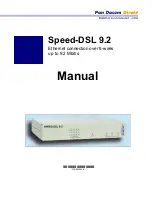
•
•
•
•
•
•
•
•
•
•
•
•
•
•
•
•
•
•
•
•
•
•
•
•
•
•
•
•
•
•
•
•
•
•
•
•
•
•
•
•
•
•
•
•
•
•
•
•
•
•
•
•
•
•
•
•
•
•
Hardware Component Overview
DOCSIS Module
29
Cooling and Fans
The G10 CMTS has three fan trays. The trays install into the air intake chambers in the bottom
of the chassis. Two trays install from the front and one tray installs from the rear. The front
trays contain six large fans each and the rear tray contains six smaller fans. The total
maximum power consumption of the three fan trays is 165 watts.
Each tray has one LED. If a single fan fails, the LED illuminates red and a warning event is
generated (if enabled). If multiple fans fail, a critical event is generated (if enabled). See the
JUNOSg Software Configuration Guide: Interfaces, Cable, Policy, and Routing and Routing
Protocols
for more information on event configuration.
The Chassis Control Module monitors the internal temperature of the chassis in multiple
locations. If the temperature is maintained between a lower and an upper threshold, the fans
continue to rotate at a nominal speed. If the temperature exceeds the upper threshold, the
speed of the fans and the value of the upper threshold are incrementally increased. Likewise,
if the temperature drops below the lower threshold, the speed of the fans and the value of the
lower threshold are incrementally decreased. This process continues until the temperature
and fan speed settle between the latest thresholds.
These temperature thresholds cannot be changed by a user. However, you can set
user-defined temperature thresholds by including the
temperature-threshold
statement at the
[
edit chassis
] hierarchy level (see the
JUNOSg Software Configuration Guide: Getting Started
and System Management
for more information).
The chassis directs the air flow upward through the card cage, then past the power supplies
and power transition modules. There is a 97-mm high air intake chamber with front and side
openings at the bottom of the chassis. Air exits through a 71-mm high chamber at the top of
the chassis through a rear opening and through the power transition modules in the rear.
The presence of the various modules is part of the air flow design. In a chassis that is not fully
populated, you must install air management modules, air management panels, and power
supply filler panels in all unused module slots to maintain proper air flow. You must also
install the power supply faceplate to ensure proper air flow.
The G10 CMTS must be installed in an open rack to ensure adequate air flow.
DOCSIS Module
The DOCSIS Module contains the circuits, devices (including the Broadband Cable Processor
ASIC), and code that provide the core functionality and features of the G10 CMTS.
The DOCSIS Module connects with the HFC Connector Modules or SIMs in the rear of the
chassis through the midplane. This keeps the cabling in back of the chassis. See “HFC
Connector Module” on page 50 and “Switched I/O Module” on page 53 for more discussion.
Figure 12 on page 30 shows the DOCSIS Module front panel.
Summary of Contents for G10 CMTS
Page 8: ... JUNOSg 3 0 G10 CMTS Hardware Guide viii ...
Page 18: ... JUNOSg 3 0 G10 CMTS Hardware Guide 2 ...
Page 34: ...G10 CMTS Hardware Overview JUNOSg 3 0 G10 CMTS Hardware Guide 18 ...
Page 82: ... JUNOSg 3 0 G10 CMTS Hardware Guide 66 ...
Page 112: ...Rack Mounting JUNOSg 3 0 G10 CMTS Hardware Guide 96 Figure 25 Air Flow Through Chassis ...
Page 148: ... JUNOSg 3 0 G10 CMTS Hardware Guide 132 ...
Page 156: ...Upstream RF Measurement JUNOSg 3 0 G10 CMTS Hardware Guide 140 ...
Page 188: ... JUNOSg 3 0 G10 CMTS Hardware Guide 172 ...
Page 196: ...Radio Frequency RF Specifications JUNOSg 3 0 G10 CMTS Hardware Guide 180 ...
Page 202: ...EIA Channel Plans JUNOSg 3 0 G10 CMTS Hardware Guide 186 ...
Page 203: ... 187 Part 5 Index Index on page 189 ...
Page 204: ... JUNOSg 3 0 G10 CMTS Hardware Guide 188 ...
Page 210: ... Index JUNOSg 3 0 G10 CMTS Hardware Guide 194 ...
















































